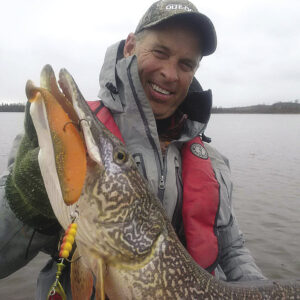As a young fishing fanatic growing up in Thunder Bay, I’d often dream about fishing the many bodies of water close to home. The mighty Nipigon River and its huge source lake were at the top of the list, due to the legendary brook trout that were said to reside there.
However, the one area not on my radar screen was a huge bay on Lake Superior just east of Thunder Bay. In the 1970s and 80s, no anglers really talked much about Black Bay. This was partially because of poor access to the expansive bay, but mostly due to the huge and somewhat intimidating presence of a commercial fishing industry that seemed to own the bay. Some of that was perception, granted, but there was a lot of netting going on for a very long time. The focus of that commercial fishing was initially walleye, but later included pike and perch. There was some angling done in Black Bay for sure, but it was mostly locals who were located on the water or were very close to it.

Less than a decade ago, things started to happen. For starters, several conservation and local fish and game groups, as well as the Ontario Federation of Anglers and Hunters and Northwestern Ontario Sportsman’s Alliance, started to encourage the Ontario Ministry of Natural Resources and Forestry to take a more active interest in managing the bay for sport fishing. At the same time, the commercial interest on the bay started to decline. Much of the netting in Black Bay stopped. On top of that, a long closed public access near Hurkett was re-opened. There was some re-stocking of walleye in Black Bay. Much of the bay, as well as a large portion of the tributary that runs into Black Bay called the Black Sturgeon River, were closed to walleye fishing (First Nations still harvest there). The huge warm water fishery that had traditionally been in Black Bay started to rebound. And anglers began to take notice.
My first Black Bay fishing experience took place in the winter about seven years ago. My buddy Sandro Fragale, of Thunder Bay, had heard reports of big perch being caught in the bay. Since we had always been trying to find consistent winter perch—without success—it seemed appropriate to at least try and find them on this huge bay. We left from the Hurkett launch and drove our sleds south on the bay. It was expansive beyond our expectations, and we had no clue where to try.
So we did what any other angler would have done and headed for signs of human activity on the ice; in this case, two empty ice fishing shacks. We dug our holes about 50 yards away, hoping we would be close enough to the hotspot to catch a few perch. Although we had driven several miles out in the bay, the water was only 17 feet deep. We caught about a dozen perch from 10 to 14 inches. True jumbos. The fish were pale and fat—quite unlike the inland perch that were so vividly marked. Our winter perch honey hole was finally a reality. And it was a big one. These days, two outfitters now rent shacks on the bay for perch. It’s become a very popular winter fishery.
In my experience, the Black Bay fishery is unique compared to most fishing on the Canadian side of Superior. It is a warm water fishery with the predominate species being walleye, pike, perch and smallmouth bass. Most of the water in this giant bay is relatively shallow, turbid and dotted with large beds of cabbage. Islands and reefs are fish magnets as they provide both rocky structures and places for baitfish to hang out. Due to its clay bottom and general fertility, Black Bay grows very big fish. Trophy-sized pike and bass can be caught just about everywhere in the northern reaches of the bay. The average walleye is also large, although fishing for them in Black Bay is only allowed south of Bent Island. Walleye are still in rehabilitation mode and remain well below historic population levels.
As you venture to the southernmost reaches of the bay, the coldwater fishery kicks in. Trolling for salmon at the mouth of Black Bay is a popular summer past time. The Chinook are relatively numerous and of a good average size. Plentiful herring seems to be the key to Chinook salmon being around. In the deeper water, lake trout are quite common and there are some sea monsters. Lakers over 20 pounds are caught each year from Black Bay.
On the down side, the resurgence of the native warm water fishery in Black Bay has had a detrimental effect on the steelhead and coaster brook trout fishery. Steelhead runs have taken a noticeable and precipitous downturn in all Black Bay tributaries. Lake brookies are also having a hard time. Whether this is a short time dip or the way things will be now remains to be seen. But the boom in the warm water fishery has meant some changes to what’s swimming around in Black Bay.






